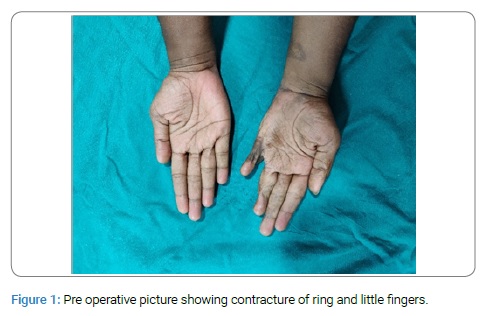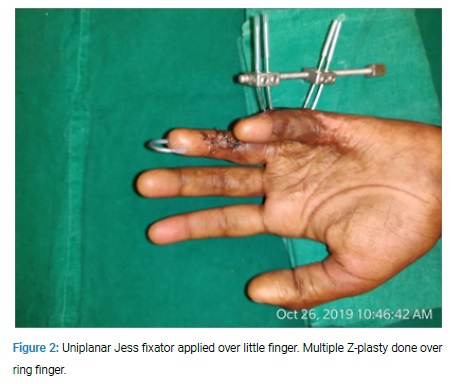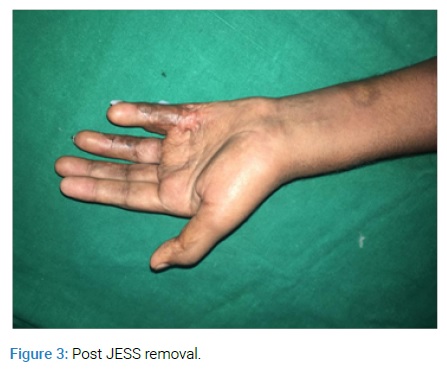Abstract
Post burn contractures of the hand are very common. The most important aspect of release of these contractures is to provide a functional hand. There are various methods of release of these contractures depending on if they are on the dorsal or volar aspect of the hand. We have used distraction assisted management of post burn contracture of the little finger.
Introduction
Hand is especially a risky part in regards to the burns because of its exposure and the importance of its functionality [1]. Even if the burned area is small, the thermal damage and contracture can affect the functionality of the hand. Long standing cases and in patients with deeper burns like in electrical burns there is not only contracture of the skin, but there might also be joint, ligament and tendon shortening. Post of the burn contractures of the hand are treated with graft, local flap, regional flap, microvascular flap [2]. One method we adopted for post burn contracture management is use of External Distraction System (JESS), for slow, sustained soft tissue distraction.
Methodology
This study was conducted in department of plastic surgery in a tertiary care centre. Our patient was a 24 year female with post burn post graft contracture of 22 years duration. The contracture was seen over the ring and little fingers. The contracture over the left little finger extended from the metacarpophalangeal joint to distal interphalangeal joint with mild rotation deformity of the little finger apparent. The apparent defect was 1.5 cms and true defect of 6 cms. After appropriate informed consent little finger treated with mini external fixator (JESS) with distraction. Multiple Z-plasty was done for ring finger (Figure 1).

Multiple K wires of 1.2 mm size were introduced percutaneously in the middle and proximal phalanx. Horizontal uniplanar JESS was fixed and distraction done at the rate of 0.25 cm every 6th hourly over 2 weeks. After no further distraction was possible, 1.5 mm K wire placed in the 5th metacarpal and distraction continued over next 3 weeks (Figure 2).

Complete extension of the finger achieved (Figure 3). In the meantime, physiotherapy was done for the other fingers.

Results
Complete release of the contracture was achieved for the little finger at the end of 6 weeks.
Discussion
External fixating systems are a popular choice in open fractures with associated injuries. If a distractor is added to it, it can not only help in stabilisation of the bone it can also help in unidirectional tissue expansion. Post burn contractures, ear functionally disabling to the patient. Long standing contractures usually have joint, tendon and ligament shortening along with skin contractures. On releasing the skin contracture, there might be incomplete release due to tendon or ligament shortening. Another possibility is that even though there is complete release, there might be exposure of tendons. Such cases will require flap cover. Flap on the volar aspect will cause some hindrance in movements. Majority of the flaps are insensate, which again might not give optimal functional outcome. In our patient we have used a uniplanar JESS fixator. This lead to slow sustained stretching of the skin, tendon and ligaments. This also helped to stabilise the joints and helped in physiotherapy. Even though not done in our patient it would be prudent to do histopathological examination of the tissue to definitively know the mechanism of expansion, if it’s only mechanical stretching or if there is hyperplasia of cells in dermis, soft tissue. We have not found any literature on the use of distraction for post burn contracture management. Our preliminary experience with it has been positive. One disadvantage is that the K- wire pin tract infection might occur which can cause osteomyelitis. Also, in long standing cases prolonged immobilization can cause osteoporosis [3]. Passing a K-wire in them might lead to fractures. So, care has to been taken both intra-operatively and post-operatively.
Conclusion
Distraction assisted management of post burn contracture can achieve good results in our experience. However, it is a more time taking procedure. Large randomized control trials are required to confirm the efficacy of this treatment modality.
Keywords
Post burn contracture; Distraction; Joshi external fixation system
Cite this article
Reddy CN, Chittoria RK, Aggarwal A, Gupta S, Mohan PLB, Shijina K, et al. Distraction assisted management of post burn contracture of hand. Clin Surg J. 2020;1(2):1–2.
Copyright
© 2020 Ravi Kumar Chittoria. This is an open access article distributed under the terms of the Creative Commons Attribution 4.0 International License (CC BY-4.0).



